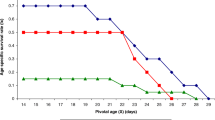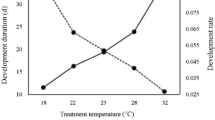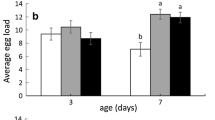Abstract
Oomyzus sokolowskii is alarval-pupal parasitoid of diamondback moth, Plutella xylostella. In a host stage preference test, the parasitoid parasitised all larval and pupal stages, but exhibited a strong preference for larvaeover prepupae or pupae, and did not show a preference among the larval instars. At 25°C, the developmental time, number and sex ratio of offspring per host pupa, and successful parasitism did not differ significantly among parasitoids reared from host larvae of different instars, indicating similar host suitability between larvae of different instars. Mean developmental times from egg to adult at 20, 22.5, 25, 30, 32.5, and 35°C were 26.5,21.0, 16.0, 12.7, 11.9 and 13.4 days, respectively. The favourable temperature range for development, survival, and reproduction of the parasitoid was 20--30°C. However, wasps that developed and emerged at a favourable temperature could parasitise effectively at 32--35°C for 24 hours. Life-fertility table studies at 20, 25, and 30°C showed that each female wasp on average parasitised 3.1, 13.2, 6.8 larvae of diamondback moth and produced 20.5, 92.1, 50.4 offspring, respectively, during her lifetime. The highest intrinsic rate of natural increase (r m) of 0.263 female/day was reached at 30°C as a result of the short mean generation time at this temperature compared to that at 20 and 25°C, suggesting that the parasitoid had the highest potential for population growth at relatively high temperatures.
Access this article
We’re sorry, something doesn't seem to be working properly.
Please try refreshing the page. If that doesn't work, please contact support so we can address the problem.
Similar content being viewed by others
References
Alam, M.M., 1990. Diamondback moth and its natural enemies in Jamaica and some other Caribbean Islands. In: N.S. Talekar (ed), Diamondback Moth and Other Crucifer Pests: Proceedings of the Second International Workshop. Asian Vegetable Research and Development Centre, Taiwan. pp. 233-234.
Chelliah, S. and K. Srinivasan, 1986. Biology and management of diamondback moth in India. In: N.S. Talekar and T.D. Griggs (eds), Diamondback Moth and Management: Proceedings of the First International Workshop. Asian Vegetable Research and Development Centre, Taiwan. pp. 63-67.
Ferronatto, E.M. and M. Becker, 1984. Abundance and complex of parasites of Plutella xylostella (L.) (Lepidoptera: Plutellidae) in Brassica oleracea L. var. acephala D.C. Anais da Sociedade Entomologica do Brasil 13: 261-278.
Hulting, F.L., D.B. Orr and J.J. Obrycki, 1990. A computer program for calculation and statistical comparison of intrinsic rates of increase and associated life table parameters. Florida Entomol. 73: 601-612.
Kfir, R., 1998. Origin of the diamondback moth (Lepidoptera: Plutellidae). Ann. Entomol. Soc. Amer. 91: 164-167.
Lima, M.L.L. and A. van Harten, 1985. Biological control of crop pests in Cape Verde — current situation and future programme. Revista Investigacao Agraria, Centro de Estudos Agrarios A 1: 3-12.
Liu, Shu-sheng, Xin-geng Wang, Shi-jian Guo, Jun-hua He and Hui-ming Song, 1997. A survey of insect parasitoids of Plutella xylostella and the seasonal abundance of the major parasitoids in Hangzhou, China. In: The Management of Diamondback Moth and Other Crucifer Pests — Proceedings of the Third Workshop. MARDI, Malaysia. pp. 61-66.
Mushtaque, M., 1990. Some studies on Tetrastichus sokolowskii Kurd. (Eulophidae: Hymenoptera), a parasitoid of diamondback moth in Pakistan. Pakistan J. Zool. 22: 37-43.
Noda, T., S. Miyai and S. Yamada, 1996. Larval and pupal parasitoids of diamondback moth, Plutella xylostella (L) in cabbage fields in Moriok, Japan. Japanese J. Appl. Entomol. Zool. 40: 164-167.
Ooi, P.A.C., 1988. Laboratory studies of Tetrastichus sokolowskii. Entomophaga 33: 145-152.
Ru, N. and R.B. Workman, 1979. Seasonal abundance and parasites of imported cabbage-worm, diamondback moth, and cabbage webworm in northeast Florida. Florida Entomol. 62: 68-69.
SAS Institute, 1995. JMP Statistics and Graphics Guide, Version 3.1, Institute, Cary, N.C.
Shi, Zhu-hua and Shu-sheng Liu, 1999. Influence of temperature on the development, survival and reproduction of Cotesia plutellae Kudj., a larval parasite of Plutella xylostella. Acta Phytophylacica Sinica 26: 142-146.
Tabashnik, B.E., N.L. Cushing, N. Finson and M.W. Johnson, 1990. Field development of resistance to Bacillus thuringiensis in diamondback moth (Lepidoptera: Plutellidae). J. Econ. Entomol. 83: 1671-1676.
Talekar, N.S. and W.J. Hu, 1996. Characteristics of parasitism of Plutella xylostella (Lep., Plutellidae) by Oomyzus sokolowskii (Hym., Eulophidae). Entomophaga 41: 45-52.
Talekar, N.S. and A.M. Shelton, 1993. Biology, ecology and management of the diamondback moth. Annu. Rev. Entomol. 38: 275-301.
Talekar, N.S. and J.C. Yang, 1991. Characteristic of parasitism of diamondback moth by two larval parasites. Entomophaga 36: 95-104.
Waterhouse, D.F. and K.R. Norris, 1987. Biological Control — Pacific Prospects. Inkata Press, Melbourne.
Yassen, M., 1978. The establishment of two parasites of the diamondback moth Plutella xylostella (Lep.: Plutellidae) in Trinidad, W.I. Entomophaga 23: 111-114.
Author information
Authors and Affiliations
Corresponding author
Rights and permissions
About this article
Cite this article
Wang, Xg., Liu, Ss., Guo, Sj. et al. Effects of host stages and temperature on population parameters of Oomyzus sokolowskii, a larval-pupal parasitoid of Plutella xylostella. BioControl 44, 391–403 (1999). https://doi.org/10.1023/A:1009912420598
Issue Date:
DOI: https://doi.org/10.1023/A:1009912420598




